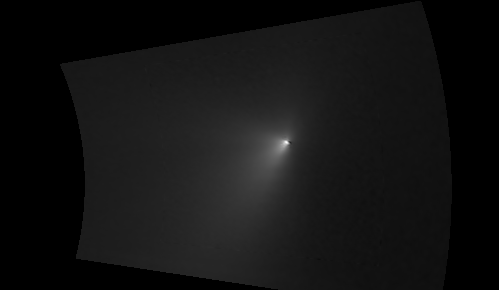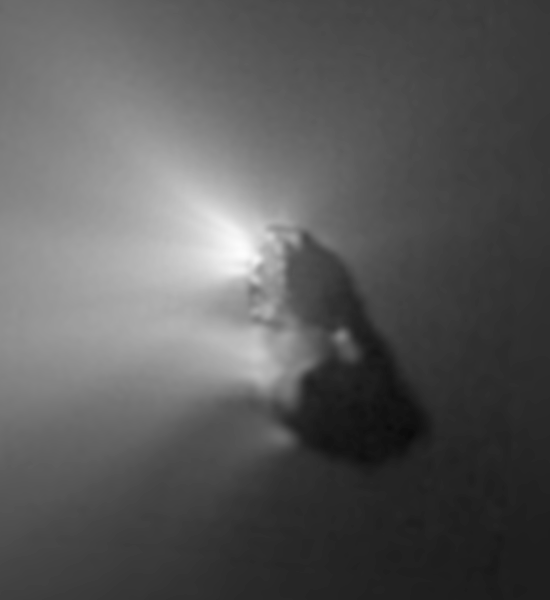|
The Halley Multicolour Camera (HMC)
HMC was the imaging system on the
 European Space Agency's
European Space Agency's
 Giotto
spacecraft and was the only remote sensing instrument on board which
could look at the nucleus of comet Halley. It was built by a
consortium led by the Max-Planck-Institut fuer Sonnensystemforschung.
Giotto
spacecraft and was the only remote sensing instrument on board which
could look at the nucleus of comet Halley. It was built by a
consortium led by the Max-Planck-Institut fuer Sonnensystemforschung.
HMC design
 Giotto
(unlike
Giotto
(unlike  NASA's
NASA's
 Voyager, for example)
was a spin-stabilised spacecraft and had a rotation period of 4s. The
rotation axis pointed roughly in the direction of motion of the
spacecraft with respect to the cometary nucleus. Imaging from a
spin-stabilised platform during a fast (68 km/s) fly-by of an object
is extremely difficult because the camera must track the object
through the fly-by despite the fact that the object only passes
through the field of view for a small fraction of the rotation
period. This is illustrated in the
Voyager, for example)
was a spin-stabilised spacecraft and had a rotation period of 4s. The
rotation axis pointed roughly in the direction of motion of the
spacecraft with respect to the cometary nucleus. Imaging from a
spin-stabilised platform during a fast (68 km/s) fly-by of an object
is extremely difficult because the camera must track the object
through the fly-by despite the fact that the object only passes
through the field of view for a small fraction of the rotation
period. This is illustrated in the
 accompanying diagram.
accompanying diagram.
HMC was a 16 cm diameter modified Ritchey-Chretien type f/7 telescope
with a focal plane split into two sections by a silvered prism. At the
aperture an additional plane mirror was mounted at 45 degrees to the
optical path which allowed the main body of the experiment to sit
behind the spacecraft bumper shield. Only this plane mirror (called
the turret mirror) and the 30 cm long Kevlar baffle (used to reduce
straylight) were exposed to impacts from dust emitted by the comet.
As detectors in the split focal plane, HMC used two of the first CCD
detectors ever to be flown in space. It was not possible to cool the
detectors (as one normally would) because of power and mass
limitations. Consequently, the dark current was a significant problem
with the resulting data and had to be calibrated very accurately post
factum. A full calibration of the data took nearly 3 years.
![[Top]](/images/icons/top.gif)
Data returned
HMC returned over 2000 images of the nucleus and the inner coma of
comet Halley over a period of 3 hours. The most useful images were
through four broad-band filters (clear, red, blue and orange). The
first images were obtained at a scale of 17 km/px (20 times better
resolution than simultaneous ground-based measurements) from a
distance of 750,000 km. In these images the asymmetry of the dust coma
could be clearly seen. The nucleus was detected for the first time 30
minutes before closest approach from a distance of 124,000 km. The
best images were obtained 5 minutes before closest approach and showed
the whole nucleus and dust jets streaming away from active regions on
the surface. All data were transmitted immediately in case the
spacecraft or the camera were destroyed during the fly-by. To
facilitate this, smaller images centred on the brightest part of the
scene were transmitted in the last 5 minutes. These showed parts of
the nucleus in ever increasing detail revealing topographic features
on the surface.
Closest approach occurred at 00:03:01.84 UT on March 14, 1986, at a
distance of 596 km from the centre of the nucleus.
![[Top]](/images/icons/top.gif)
Images

The nucleus of comet Halley resolved. This image was taken from
124000 km, 30 minutes before closest approach. The nightside of the
nucleus can be seen for the first time just to the right of the
brightest emission.

A composite image of the nucleus of comet P/Halley. This image
is composed of 68 images of varying resolution. The data at the
brightest point on the nucleus is at the highest resolution (50
m). The Sun comes from 30 deg above the horizontal to the left and is
17 deg behind the image plane (observation phase angle of 107 deg).
The night side of the nucleus can be seen silhouetted against a
background of bright dust in the far-field. Jets can be seen
originating from two regions on the nucleus. Structure can be seen
within the jets. A bright area is seen within the night side of the
nucleus. We believe this to be a hill or mountain approximately 500 m
high. Other surface details can be seen in the illuminated region.
A large scale version of the above
 image (1.3MB).
image (1.3MB).
 The outline of the nucleus shows a highly
elongated body with axes roughly in the dimension 1:2.
The outline of the nucleus shows a highly
elongated body with axes roughly in the dimension 1:2.
![[Top]](/images/icons/top.gif)
Results
The main results of the Halley Multicolour Camera can be summarised as
follows.
|
The nucleus
- The nucleus of comet Halley is an irregular, elongated body of
dimensions 15.3 x 7.2 x 7.2 km3, a volume of 400 km3, and a
surface area of 300 km2.
- The nucleus is slightly red and dark with an albedo of 0.04.
- The photometric phase function of the surface is probably
Moon-like.
- Our best estimate for the density is around 0.6 g cm-3.
- Activity (dust emission) from the nucleus is restricted to between
10-15% of the surface area.
- Active regions are typically 10 km2 in area.
- About 6 m depth of material is lost from an active region per orbit
around the Sun.
- The observed topography indicates structural strength of the
surface.
- Following prolonged discussions, its mode and period of rotation
remain uncertain.
|
| |
|
Near-nucleus dust
- Three major jets were evident.
- The maximum emission of dust was not directly towards the Sun but
towards a direction 30 deg south of the comet-Sun line.
- This direction changed slightly during the encounter (probably
because of the rotation of the nucleus).
- The dust emission rate was constant to within 1% for a period of
three hours during the encounter.
- Dust is swept around from the dayside to the nightside by the
expanding gas flow.
- Large particles dominate the mass loss from the nucleus.
- Dust to gas ratios of around 2 are consistent with observations.
- The dust was slightly redder than the nucleus itself.
|
![[Top]](/images/icons/top.gif)
HMC's fate
9 seconds before closest approach, HMC stopped functioning. Subsequent
analysis showed that the microprocessors in the instrument electronics
had experienced a power glitch. It took 45 minutes to bring the system
back-up again (principally because of the length of time required to
communicate with the spacecraft which was more than 15 minutes). An
attempt to rotate HMC to view the comet failed because the rotation
was obstructed. No images post-encounter were obtained. In 1990, a
full check-out of HMC was made to see whether the camera could support
a fly-by of comet Grigg-Skjellerup in July 1992. It was found that the
optical path was blocked, probably by the straylight baffle. This
baffle was almost certainly smashed by repeated dust impacts during
the Halley encounter. It was now wrapped around the turret mirror
blinding the rest of the optics. Everything else seemed to be working
but HMC couldn't even see the Sun!
July 10, 1992. Several of the other experiments on board Giotto were
still functional and returned data on the plasma interaction between
the solar wind and the comet. This was probably the closest a
spacecraft has yet been to a comet but without HMC, we don't know how
close.
![[Top]](/images/icons/top.gif)
Where to get the data
All useful data from the encounter have been released on CD-ROM by the
International Halley Watch. The CDs are available from the
 NSSDC,
Washington.
NSSDC,
Washington.
![[Top]](/images/icons/top.gif)
References to help you analyse the data
|
Instrument description - Keller et al., J. Phys. E., 20, 807, (1987) |
|
Noise reduction - Kramm and Keller, SPIE, 1027, 180, (1988) |
|
PSF correction - Kramm et al., Geophys. Res. Lett., 14, 677, (1987) |
|
Absolute calibration - Thomas and Keller, Applied Optics, 29, 1503, (1990) |
|
First results - Keller et al., Astron. Astrophys., 187, 807, (1987) |
|
Fly-by geometry - Curdt et al., Astron. Astrophys., 191, L1, (1989) |
|
Large particle impacts - Curdt and Keller, Icarus, 86, 305, (1990) |
|
Dust jets analysis - Reitsema et al., Icarus, 81, 31, (1989) and Thomas and Keller, Annales. Geophys., 8, 147 (1990) |
|
The nucleus - Keller (1992) in Physics and Chemistry of Comets, pub. Springer-Verlag, ed. W.F. Huebner |
A two-volume catalogue of HMC and Russian
 Vega
spacecraft TVS images from the fly-bys of comet Halley in March 1986
can be obtained from the
Vega
spacecraft TVS images from the fly-bys of comet Halley in March 1986
can be obtained from the
 Publications Division of ESA. The publication number is ESA
SP-1127 and is entitled "Images of of the Nucleus of Comet
Halley". This contains a full description of HMC, how the data has
been reduced, and the main scientific results.
Publications Division of ESA. The publication number is ESA
SP-1127 and is entitled "Images of of the Nucleus of Comet
Halley". This contains a full description of HMC, how the data has
been reduced, and the main scientific results.
Several of the
 images used to produce the HMC catalogue are now available.
Please note that text placed over the images during the printing process
is often not present on these original images.
images used to produce the HMC catalogue are now available.
Please note that text placed over the images during the printing process
is often not present on these original images.
MPS Publications
![[Top]](/images/icons/top.gif)
Future missions
The Giotto mission has prepared the way for more ambitious missions to
comets. The
 Rosetta mission to comet Wirtanen will attempt to land on the
nucleus and analyse the surface in situ. The
Rosetta mission to comet Wirtanen will attempt to land on the
nucleus and analyse the surface in situ. The
 Stardust
mission will attempt to collect samples of cometary material as it flies
past comet Wild 2 and return them to Earth.
Stardust
mission will attempt to collect samples of cometary material as it flies
past comet Wild 2 and return them to Earth.
![[Top]](/images/icons/top.gif)
Copyright
The images shown herein may be used for educational purposes if the
source (MPS) is given. However, all images herein are © MPS,
1986, 1996 and may not be used for commercial purposes without the
permission of H.U. Keller at the Max-Planck-Institut fuer Sonnensystemforschung,
Katlenburg-Lindau, Germany.
|
